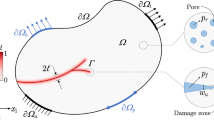Abstract
The problem of a subsurface crack parallel to the surface of a half space was studied by the finite element method. Without using the interface or gap elements over the crack faces, the crack faces would penetrate into each other for the traction-free boundary condition under shear loading, which is physically impossible. Using the gap elements, this problem was avoided, and a contact zone was observed near one crack tip. The size of the contact zone decreases but the maximum contact pressure at the closed crack tip increases as the crack approaches the surface. For tensile and shear loadings, both K I (mode I stress intensity factor) and K II (mode II stress intensity factor) increase as the crack approaches the surface. For shear loading there is no K I at the closed tip and the K I and K II at the open tip are comparable as the crack approaches the surface.
Similar content being viewed by others
References
F.Erdogan, SIAM Journal of Applied Mathematics 17 (1969) 1041
S.H.Chen, L.M.Keer and J.D.Achenbach, International Journal of Engineering Science 18 (1980) 225
Y.Higashida and K.Kamada, International Journal of Fracture 19 (1982) 39
Y.Murakami, Stress Intensity Factors Handbook, Pergamon Press, New York (1987)
E.G.Ladopoulos, Ingenieur-Archiv 58 (1988) 35
S.Itou, International Journal of Fracture 67 (1994) 179
Fuqian Yang and J.C.M. Li, to be published
D.Schmueser, M.Comninou and J.Dundurs, International Journal of Engineering Science 18 (1980) 1149
M.Comninou, D.Schmueser and J.Dundurs, International Journal of Engineering Science 18 (1980) 131
G.R.Miller, ASME Journal of Tribology 110 (1988) 292
L.M.Keer, M.D.Byrant and G.K.Haritos, ASME Journal of Lubrication Technology 104 (1982) 347
D.A.Hills and D.W.Ashelby, Engineering Fracture Mechanics 13 (1980) 69
A.R.Rosenfield, Wear 61 (1980) 125
D.A.Hills and D.W.Ashelby, Wear 54 (1980) 321
Y.P.Chiu, T.E.Tallian and J.I.McCool, Wear 17 (1971) 433
J.T.Oden and G.F.Carey, Finite Elements: Special Problems in Solid Mechanics, Vol. 5, Prentice-Hall, Englewood Cliffs, NJ. (1984)
G.N.Pande, G.Beer and J.R.Williams, Numerical Methods in Rock Mechanics, John Wiley & Sons, NY. (1990), Chapter 6
ABAQUS 5.2, Standard User's Manual I, Hibbitt, Karlsson & Sorensen, Inc. (1992)
M.H.Aliabadi and D.P.Rooke, Numerical Fracture Mechanics, Kluwer Academic Publishers, London (1991)
F.Chirino and J.Dominguez, Engineering Fracture Mechanics 34 (1989) 1051
P.S.Theocaris, G.Tsamasphyros and E.E.Theotokoglou, Engineering Fracture Mechanics 20 (1984) 583
Y.K.Cheung and Y.Z.Chen, Engineering Fracture Mechanics 28 (1987) 31
Author information
Authors and Affiliations
Rights and permissions
About this article
Cite this article
Yang, F., Qian, C. & Li, J.C.M. Finite element analysis of a subsurface crack. Int J Fract 77, 337–350 (1996). https://doi.org/10.1007/BF00036251
Received:
Accepted:
Issue Date:
DOI: https://doi.org/10.1007/BF00036251




